The major metropolitans Dallas, Houston and Austin get most of the headlines, but cities and regions outside those cities are doing their bit to keep the Texas economy booming or, in the case of Brownsville, blasting off.
The city announced in early August that
SpaceX had chosen a site on Boca Chica Beach to be the home of SpaceX’s vertical rocket launch facility. The project is expected to create 300 jobs and pump $85 million in capital investment into the local economy. SpaceX, founded in 2002 by visionary businessman Elon Musk, designs, manufactures and launches rockets and spacecraft. The company took its time choosing its new launch site. The highly competitive process took three years. California, Florida, Georgia, Virginia and Puerto Rico were all considered before SpaceX settled on the Brownsville location.
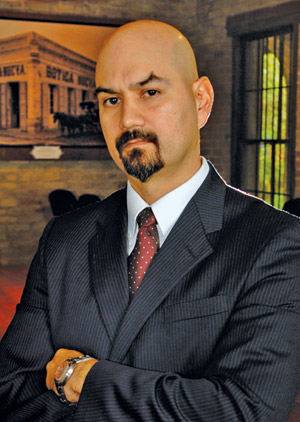
Gilberto Salinas serves as executive vice president of the Brownsville Economic Development Corporation.
Paul Chouy/University of Texas at Brownsville
“The main driver of interest from the beginning was our geographic location,” says Gilberto Salinas, executive vice president of Brownsville’s Economic Development Corporation (BEDC). “But that didn’t mean it was a done deal, at all. It was a process, from getting support across the board, going through the environmental regulatory issues and then the financial aspect. We’re a community of 200,000 – we wondered if we could make this happen.”
In fact, Salinas says the project was on life support several times during the process. “We found out that we had to close the beach in order to launch,” he says. “It’s a public beach – owned by the state – you can’t close it for commercial purposes.” Community leaders asked the state legislature to amend the law to allow for the southern-most public beach in the state of Texas to be closed six to fifteen hours prior to a launch. Environmental concerns ranged from disturbing ocelot habitats and wetlands to impinging on a historic Civil War battle site. Once those points were satisfactorily resolved, the Federal Aviation Administration had to provide its approval.
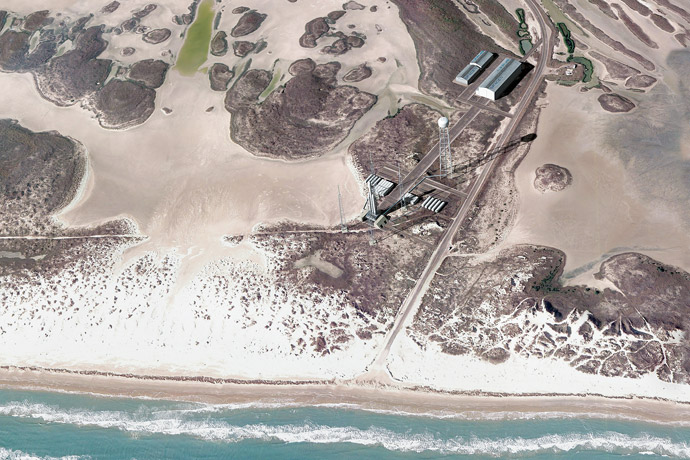
A rendering of the SpaceX vertical rocket launch facility at Boca Chica Beach near Brownsville.
Image courtesy of Brownsville Economic Development Corporation
Other states came in with handsome financial incentives, but the Texas Enterprise Fund (TEF) offered $2.3 million to help seal the deal, and the Spaceport Trust Fund offered $13 million to fund infrastructure developments.
The local school district is ramping up its already strong emphasis in the STEM fields. And the University of Texas-Brownsville Department of Physics and Astronomy will play a large role in helping provide educated, skilled workers for the company. “SpaceX has said, ‘Give us your best physics and math students. We’ll get them and mold them into what we want,’ ” says Salinas. “We’re one of the youngest cities in the US – our average age is 26 to 27. This project is just the beginning of many good things to come for the new generation entering the workforce, the millennials. I can’t wait to see what this place will look like 10 to 20 years from now.”
“This project has infused the community with self-confidence and is inspiring a lot of people.
You can’t buy that. We’re definitely walking 10 feet tall now.”
-Gilberto Salinas, executive vice president, Brownsville Economic Development Corp.
Brownsville isn’t the only starry-eyed Texas city.
XCOR Aerospace in Midland kicked off the renovation of its Commercial Spaceflight Research and Development Center Headquarters with a ceremonial wall breaking. The new facility will house XCOR’s Lynx suborbital spacecraft, corporate headquarters and the company’s research and development division. Renovations are expected to be complete by summer 2015. The company aims to become the “most active spaceflight company in the world’ by offering passengers suborbital flights at a cost of $95,000 to $100,000, depending on the spacecraft. The fee includes medical screening and g-force training.
El Paso Embraces BRAC, Baseball and Business Expansion
On the western tip of Texas, another border city – El Paso – is experiencing a boom that has little to do with oil, natural gas or spaceships. Instead, the city’s growth is tied to the US Army’s Base Realignment and Closure (BRAC) and proximity to the Army’s second largest military installation, Ft. Bliss. Thanks to BRAC, the population of Ft. Bliss has more than doubled in the past eight years as soldiers and their families have moved to the area. And it’s not just active-duty military moving to the region. Thanks to the state’s tax-friendly climate and the Ft. Bliss amenities, El Paso is the number one city for military retirees.
The post added housing, shopping and is currently building a new $648 million hospital to replace William Beaumont Army Medical Center. The 1.1 million-sq.-ft. (102,200-sq.-m.) healthcare campus will include a seven-story hospital, clinics, administrative building and a clinical investigation building with Biosafety Level 3 laboratories. The project is slated to be completed in 2016.
Another facet to the city’s growth is tied to investing in quality of life and embracing the notion of placemaking, creating a place where people want to live, work and play, especially in downtown El Paso. Newcomers to El Paso are discovering a remade city due to a series of Quality of Life bond referenda that are creating a lively downtown with new and improved amenities like parks, museums, libraries and cultural opportunities. Much of the newfound excitement was driven by a new sports venue.

Southwest University Ballpark in downtown El Paso was named the Ballpark of the Year by Baseballparks.com. The stadium opened on April 28.
Photo by Ivan Pierre Aguirre
Southwest University Park, home to the El Paso Chihuahuas, the Triple-A affiliate of major league baseball’s San Diego Padres, opened in April 2014 and has already garnered rave reviews. Built through a public-private partnership in 11 months on just five acres of land, the site of former city hall, Southwest University Park was recently named Baseballparks.com Ballpark of the Year for 2014, a big honor for a minor league ballpark. The award recognizes a new or remodeled baseball stadium with the best combination of aesthetics, architectural design, site selection and fan amenities.
“From the outset, our objective was to build a first-class facility,” said Josh Hunt, managing partner of MountainStar Sports Group, which owns the team. “The unique design was a key factor. The project team started with a small, tight amount of land in the heart of our city, and turned it into a ballpark with distinct ‘neighborhoods’ that make up the total venue.”
The final cost for the project was $75 million, with $64 million from the city and $11 million from the ownership group. Fans from both sides of the border have embraced the team and the ballpark. The team set a new single-season attendance record for Minor League Baseball in El Paso in early July. To date more than 335,000 fans have visited the ballpark since its April 28th opening.
The city also invested in its transportation system, Sun Metro, and is building a $140-million four-corridor bus rapid transit system. The system will function like light rail on wheels with special express lanes and 100 stations along 50 miles of line. Sun Metro was recently recognized by the American Public Transportation Association (APTA) as the best midsized transit system in the country.
Companies large and small are noting the changes El Paso has made and are choosing to invest in the area.
ADP, the human resources service provider, expanded its operations, creating 585 jobs and $22 million in capital investment.
Charles Schwab, a Fortune 500 company, will build an operations center in West El Paso that is expected to create 445 jobs with $21.5 million in capital investment over 10 years. The center expects to be operational by 2015.
Schneider Electric is investing $7 million to expand its facility in El Paso to house an engineered-to-order power control business line that targets data centers, hospitals and other customers requiring mission-critical electrical continuity.
LanguageLine takes advantage of El Paso’s bilingual community by locating a new Innovation Center providing translation services to 911 emergency centers and call centers for public and private enterprise. The Innovation Center expects to create hundreds of new jobs.
Texas-sized Diversity From Football to Food Processing
A sampling of recent projects throughout the state demonstrates the range of companies and industries that are investing in Texas. The Dallas Cowboys just broke ground on their new corporate headquarters and practice facility in Frisco, north of Dallas. “When we were considering potential new homes for the World Headquarters of the Dallas Cowboys, the leaders of the City of Frisco and the Frisco Independent School District [ISD] made perfect sense for our organization,” said Cowboys Chief Operating Officer Stephen Jones. “They are very forward thinking people who have a great vision for building a dynamic community. Many jobs will be created, and business opportunities will be a big part of the 91-acre (36.8-ha.), mixed-use development that is part of this project.”
The city passed a $90-million bond referendum in July to pay for a portion of the $115 million Frisco is pouring into the development. Plans call for a 12,000-seat stadium which will also be used for Frisco high school football games and other events, an outdoor plaza, a six-story team headquarters building and two private practice fields.
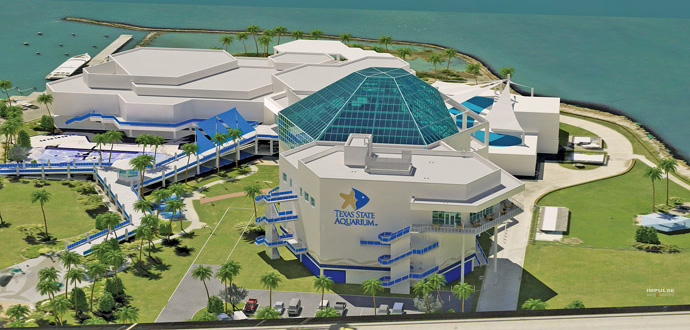
Rendering of the new addition to the Texas State Aquarium in Corpus Christi.
Image courtesy of Texas State Aquarium
Frisco isn’t the only city with a new entertainment venue. After eight months of construction, movie-goers in Temple, and the entire central Texas region, get to enjoy super-sized movies at the area’s only IMAX Theater at Temple Mall. Premiere Cinema Corporation, based in Big Spring, and the IMAX Corporation worked with the Temple Mall and city officials to bring the mammoth theater to Temple. The structure is six stories tall and houses one of the largest movie screens in the state. “We view this as an investment in central Texas which should enhance lifestyles and be a stimulus to the local economy,” said Gary Moore, CEO of Premiere.
”
Investing in Texas was an easy decision. This new expansion will allow us to take full advantage of the outstanding work ethic of our long time Eagle Pass employees and help us meet an ever growing demand for Mossberg rifles and shotguns.”
– Iver Mossberg, CEO of Mossberg
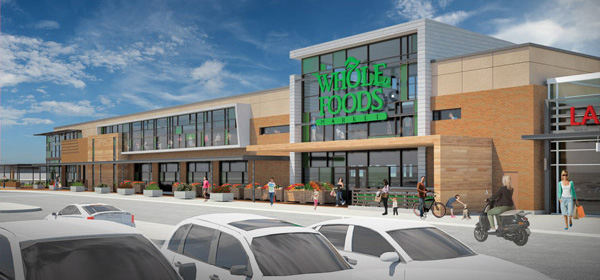
Austin-based Whole Foods Grocery will open a new grocery store in the CityLine development in Richardson.
Rendering courtesy of KDC
The Texas State Aquarium in Corpus Christi announced plans to double the size of the facility with a $50-million, 65,000-sq.-ft. (6,038-sq.-m.) Caribbean Journey addition. Longtime partner H-E-B, a Texas based grocery store company, donated $3 million to the campaign, enabling the Aquarium to commission final construction documents and move forward with a groundbreaking later this year. “The Texas State Aquarium is one of the most significant educational resources in our state,” said Rob Hall, group vice president of H-E-B Gulf Coast Region. “We believe this investment represents our passion for education and our commitment to the communities we serve.”
Maverick Arms, Inc., a firearms company specializing in shotguns, announced plans to invest $3.4 million to expand its Eagle Pass manufacturing facility, consolidating barrel production to the site and creating 50 new jobs. The Eagle Pass facility assembles and distributes firearms for the Mossberg, Maverick and Mossberg International brands. “Investing in Texas was an easy decision,” says Iver Mossberg, CEO of Mossberg. “This new expansion will allow us to take full advantage of the outstanding work ethic of our longtime Eagle Pass employees and help us meet an ever growing demand for Mossberg rifles and shotguns.”
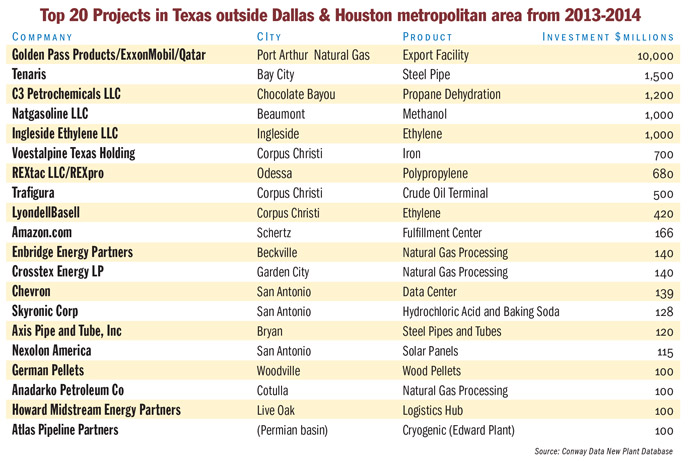
CityLine, a massive mixed-use project in Richardson, recently celebrated a milestone. The development topped out of the first of three office towers, totaling 1.5 million sq. ft. (139,350 sq. m.), which will be home to more than 8,000 State Farm employees at the overall 186-acre (75-hectare) CityLine project. CityLine developers also broke ground on a new 489,000-sq.-ft. (45,430-sq.-m.) office complex for
Raytheon, which will eventually house 1,700 employees. Austin-based Whole Foods Market announced that it will build a 40,000-sq.-ft. (3,712-sq.-m.) store in the CityLine development. “We were attracted to the vibrancy of the urban environment of CityLine, literally on the border of Richardson and Plano,” said Mark Dixon, southwest regional president of Whole Foods Market.
Speaking of groceries, when its newest expansion is complete,
Hilmar Cheese in Dalhart will produce over 1 million pounds of cheese per day. “A growing milk supply and a stable regulatory environment make Texas a great place to invest in cheese processing,” said company CEO and President John Jeter. The expansion will add 15 to 20 new jobs, increase capacity for milk receiving, cold storage and cheese block processing equipment, and is scheduled for completion in early 2015.
Creating an Identity
Salinas says getting SpaceX to locate in Brownsville is just one piece of the economic development challenge for the city, and other smaller cities in Texas. “The ‘what comes next,’ is where it’s up to us to decide whether we’re just going to settle for one company or are we going to actually leverage it and fully develop a commercial space industry cluster,” he says. “There are already two suppliers looking at the area. One of them would be a 30-employee operation, but if we get a string of companies of that type, they can add up pretty quickly.”
The SpaceX project became a rallying point for the Brownsville community that will have long-term impact in the way the city views its own capability. “We walked out of Elon Musk’s office thinking, ‘This is out of our league,'” says Salinas. “You can imagine trying to communicate that vision to the people here; they wondered what happened to the traditional companies we were recruiting.
“But here we are,” he continues. “We were able to achieve it, which is a testament to a community that believes in itself. This project has infused the community with self-confidence and is inspiring a lot of people. You can’t buy that. We’re definitely walking 10 feet tall now.”

